How to Do a Time Impact Analysis (With Examples)
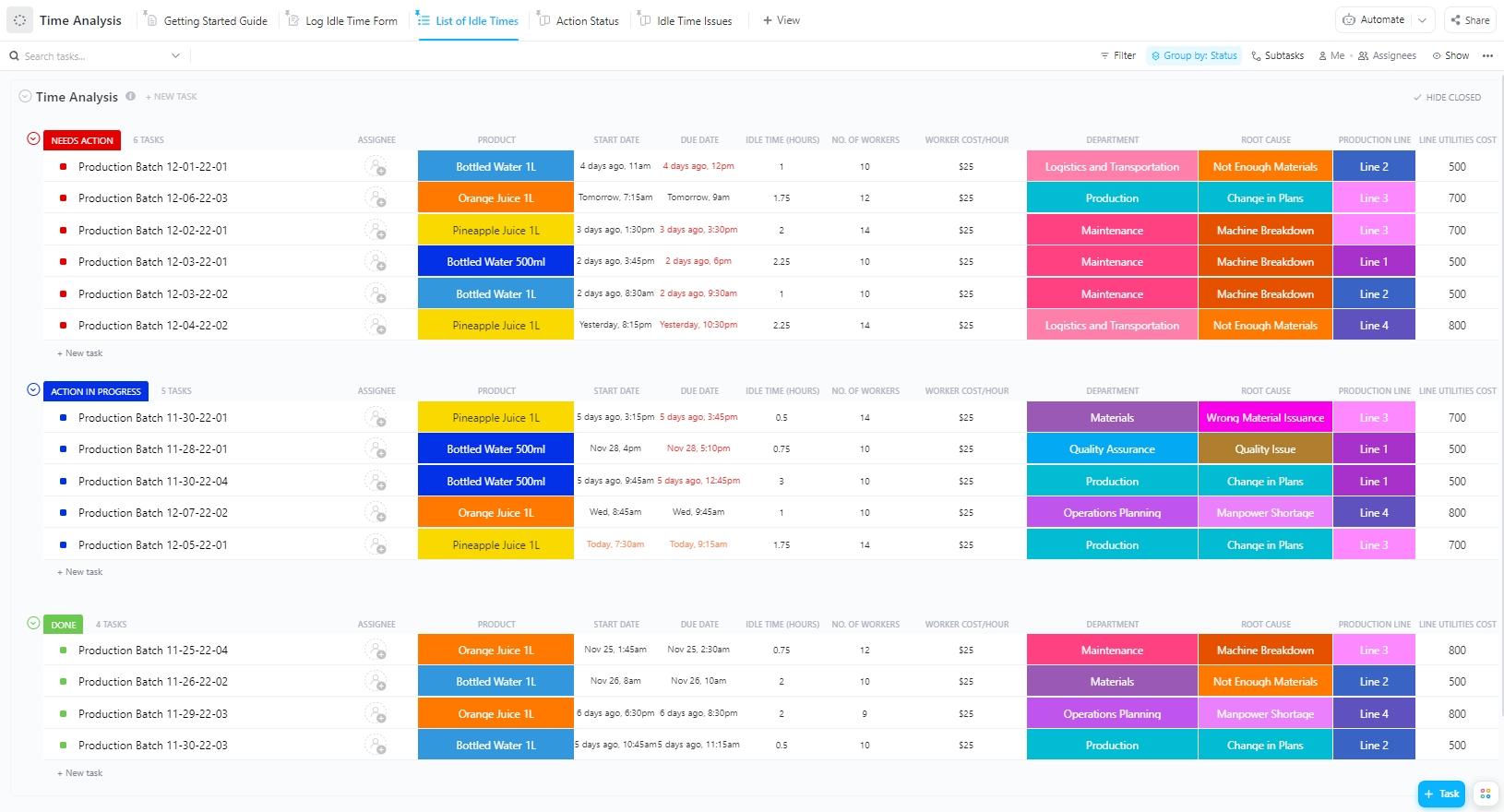
Sorry, there were no results found for “”
Sorry, there were no results found for “”
Sorry, there were no results found for “”

You’re halfway through a high-stakes infrastructure project when a delivery delay or design change suddenly derails your timeline. You know the setback isn’t your team’s fault—but how do you prove it? More importantly, how do you figure out exactly how much time it’s going to cost you?
That’s where Time Impact Analysis (TIA) comes in. 🏗️
This scheduling method helps you model potential delays and assess their impact before they spiral. Instead of guessing how a delay might affect your finish date, you can plug it into your current schedule, see what shifts, and back it up with hard data.
Whether you’re managing a construction project, engineering plan, or government contract, knowing how to perform a TIA puts you in control of delay claims, change orders, and timeline negotiations—with confidence.
In this guide, we’ll break down:
By the end, you’ll be able to analyze schedule impacts like a pro and communicate them.
The ClickUp Time Analysis Template helps teams clearly see where their time goes. By tracking time spent on tasks and projects, you can uncover patterns, eliminate bottlenecks, and boost overall efficiency.
Time Impact Analysis (TIA) is a scheduling technique used to evaluate how a specific delay—such as weather issues, late materials, or design changes—will affect a project’s overall timeline.
It’s most commonly used in construction, engineering, and infrastructure projects where a single shift in the plan can ripple across months of work. Instead of retroactively explaining what went wrong, TIA lets you simulate a delay before it happens—so you can assess its impact and take action.
Here’s how a time impact analysis works:
You insert a group of activities (called a fragnet) into your current project schedule. This fragnet represents the delay event. Once added, you recalculate the schedule to see if and how the project’s end date shifts. That delta is your time impact.
🎉 Fun Fact: The term “fragnet” is a blend of “fragment” and “network”—a mini schedule inside your master schedule.
📮ClickUp Insight: 92% of workers use inconsistent methods to track action items, which results in missed decisions and delayed execution. Whether you’re sending follow-up notes or using spreadsheets, the process is often scattered and inefficient.
ClickUp’s Tasks ensures seamless conversion of conversations into tasks—so your team can act fast and stay aligned.
At the heart of TIA is a fragnet—a miniature sequence of tasks that represents a specific delay. You drop this fragnet into your current project timeline to test what happens.
Here’s the flow:
🧠 Think of it like dropping a stone in still water.
The fragnet is the stone. The ripples? That’s your adjusted timeline. With TIA, you’re not just reacting to delays; you’re forecasting them, visualizing their impact, and steering your team toward smarter decisions.
👉 Watch how to prioritize your tasks and avoid delays!
TIA is your secret weapon when a project curveball threatens your schedule—and your credibility. 📉 But don’t worry, we’ll walk through exactly how to do it step-by-step.
💡 Pro Tip: With ClickUp, you can bring these elements to life by leveraging powerful features like Custom Fields, task dependencies, and real-time Dashboards to document, visualize, and communicate every step of your TIA process.
Delays are inevitable. Weather changes. Materials arrive late. Stakeholders request last-minute scope changes.
But what separates successful projects from delayed ones is how well you respond to disruptions when they happen.
The real risk isn’t just a delayed task—it’s a shift in your overall project completion date. Without forward-looking analysis, even minor delays can snowball into major milestone impacts. That’s where TIA shines: it turns reactive firefighting into proactive schedule control.
TIA gives you more than just a heads-up—it gives you clarity and control. It helps project managers, schedulers, and contractors get ahead of delays before they snowball into missed deadlines, strained budgets, or legal disputes.
🎉 Fun Fact: Some PMs use Time Impact Analysis scenarios as internal simulations—“what if we lost two days of crane access?” or “what if design sign-off slips again?” This helps them pre-negotiate float use and reallocation with subcontractors before delays become costly.
ClickUp’s collaborative workspace makes it easy to keep everyone on the same page. With Docs, Chat, and task comments, you can centralize all delay discussions, supporting evidence, and decisions—ensuring nothing gets lost in email threads or spreadsheets.
💡 Pro Tip: Use ClickUp’s permissions and sharing settings to control who can view or edit delay logs, TIA Docs, or Dashboards. This allows you to share real-time updates with clients or contractors securely.
Even small disruptions can lead to major setbacks in construction. That’s why project managers use schedule delay analysis techniques like TIA to protect the project completion date. Unlike retrospective methods, TIA is a prospective approach that simulates potential delays using the last accepted schedule. By inserting a fragnet into the CPM schedule, teams can predict how a delay might shift the critical path—before it happens.
Construction teams often need separate analyses to assess concurrent delays and determine responsibility when delays overlap. This requires a well-structured schedule with clear logic and dependencies—something modern tools like ClickUp help simplify. With built-in support for schedule analysis and real-time collaboration, you can track, simulate, and resolve delays more clearly.
🔍 Imagine this: You’re presenting to a frustrated stakeholder about a delay. You pull up your TIA report, show exactly where the delay occurred, how it impacted the critical path, and what you’ve done to adjust. Suddenly, the conversation is about solutions, instead of blame.
Time Impact Analysis might sound technical, but it follows a clear, repeatable process. The core steps remain the same whether you’re working in Primavera P6, Microsoft Project, or an everything app for work like ClickUp.
Using project management software that supports logic-based recalculation and documentation is essential. It ensures your analysis reflects real progress, team visibility, and risk in motion.
In most construction projects, for instance, a scheduler or planning engineer performs the TIA—often in collaboration with the project manager and, in high-stakes cases, a contract administrator or claims consultant. If there’s potential for legal review, some construction companies bring in independent delay analysts to ensure the TIA meets industry standards.
Let’s break it down into a simple workflow:
Start by pinpointing the issue that might impact your schedule. This could be anything from a delivery delay to a design revision or weather disruption. Specifically, what caused it, when did it occur, and what tasks will it likely affect?
💡 Pro Tip: Document the source and context in your delay logs, daily reports, or team communication threads. ClickUp Brain can help you quickly summarize communication threads or site updates to identify the delay trigger.
Once you’ve identified the event, you’ll need a centralized way to store the evidence—such as emails, site photos, meeting notes, and cost impacts—all in one place.
Here’s how ClickUp helps you organize delay documentation clearly and traceably:
🗂️ Centralize delay documentation in ClickUp Docs—capture cost impact, attachments, and team discussion in one place for full traceability.
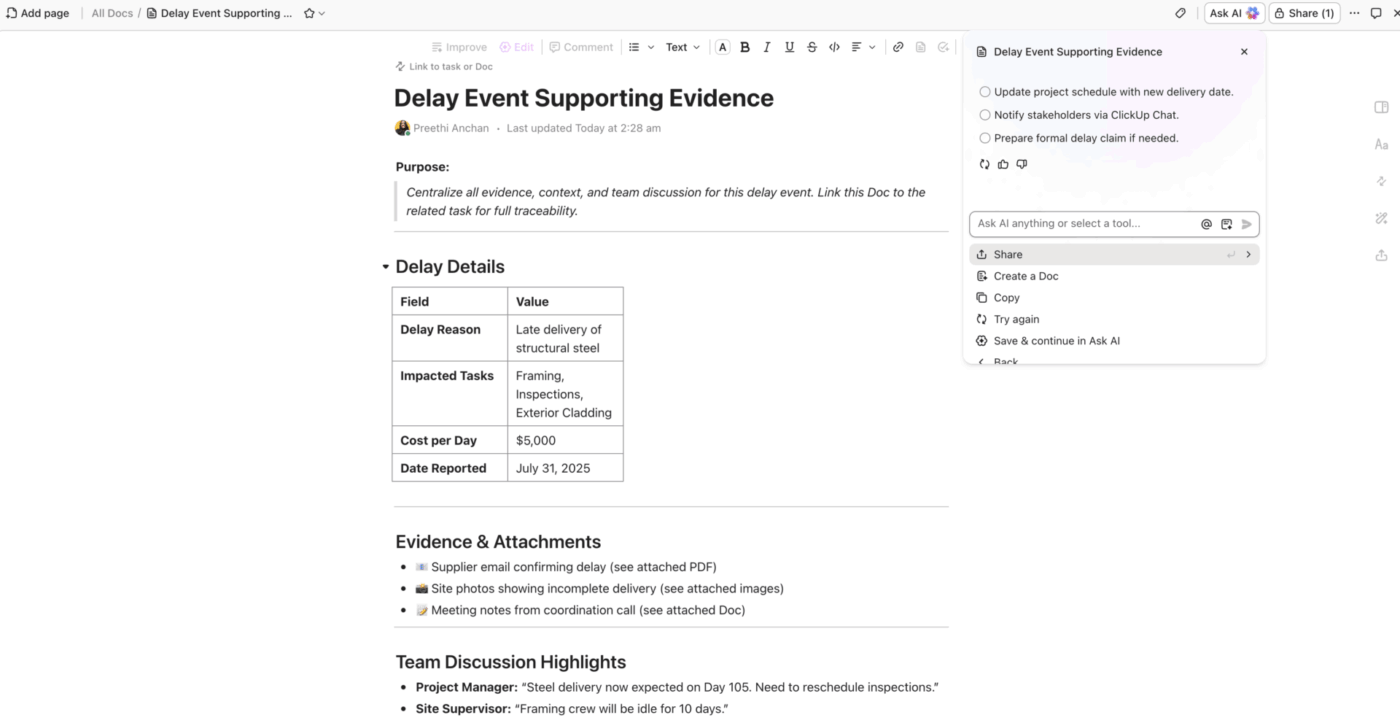
This Doc links directly to the associated task so your project manager, scheduler, and legal team can access the same source of truth—ideal for extension of time (EOT) claims or formal disputes.
Team discussions about the delay can happen in the task comments or ClickUp Chat, keeping everything documented and easy to reference.
🧐 Did You Know? According to a Dodge Data & Analytics report, 77% of construction professionals say poor schedule visibility is a leading cause of budget overruns. Tools that model and communicate delay impact can significantly reduce that risk.
ClickUp Forms let team members or field staff submit delay events from any device, ensuring nothing is missed. Submitted forms can automatically populate your Delay Log list with all required details.
ClickUp Brain can help you quickly summarize communication threads or daily reports to pinpoint the cause and context of a delay. However, it does not automatically analyze or simulate schedule impacts—summaries and insights are based on existing workspace data and require user prompts.
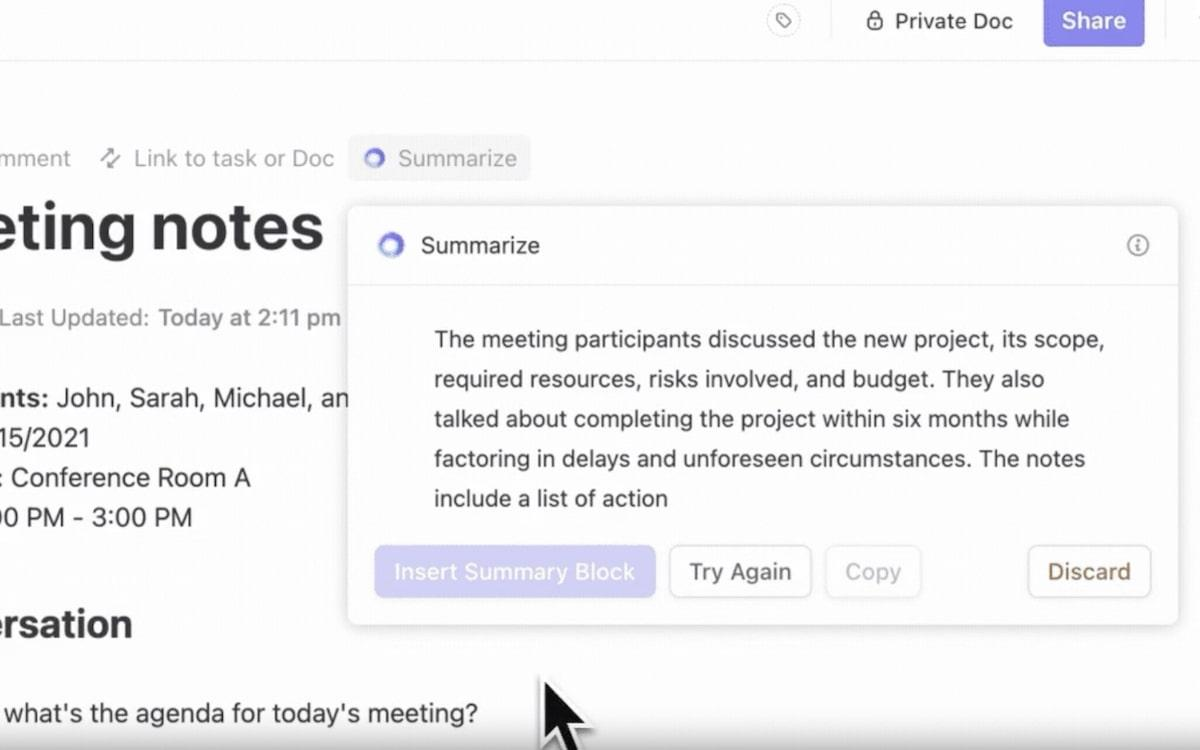
💡 Pro Tip: Automate repetitive actions: When a delay is logged, automatically notify stakeholders, assign reviewers, or update project status using ClickUp Automations.
Now, create a fragnet—a focused group of delay-related tasks that model how the disruption would realistically unfold. This may include idle time, coordination meetings, approvals, or rework activities.
Each task in your fragnet should include:
Here’s how that looks inside ClickUp’s List View:
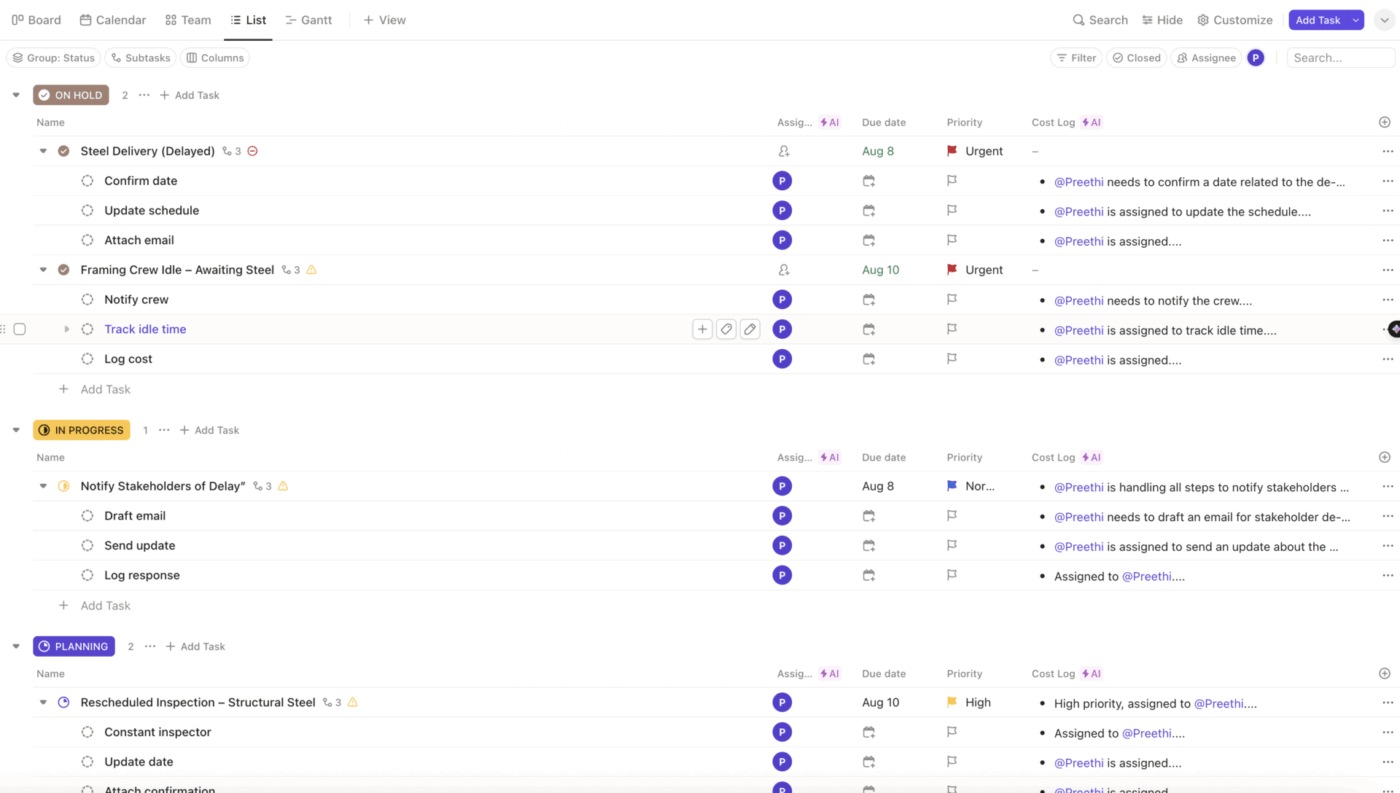
🧩 Structure fragnets as linked ClickUp Tasks or subtasks—and use Custom Fields, cost tracking, and assignees to simulate the real-world complexity of project delays.
This view gives you granular control over building the fragnet as it happens in the field. You can track idle time, add attachments, and automate follow-ups.
💡 Pro Tip: A “fragnet” is the delay model. Once it is inserted into your schedule and recalculated, a “fragnet scenario” occurs. ClickUp lets you build and test multiple fragnet scenarios side-by-side.
Additionally, using dependencies, you can show what comes before and after, set time estimates, and assign the right team members. Use task relationships (blocking, waiting on, linked tasks) to visually map how a delay cascades through your project.
If you have a common fragnet structure, save it as a task template for future use. This ensures that every TIA follows a standardized, best-practice workflow.
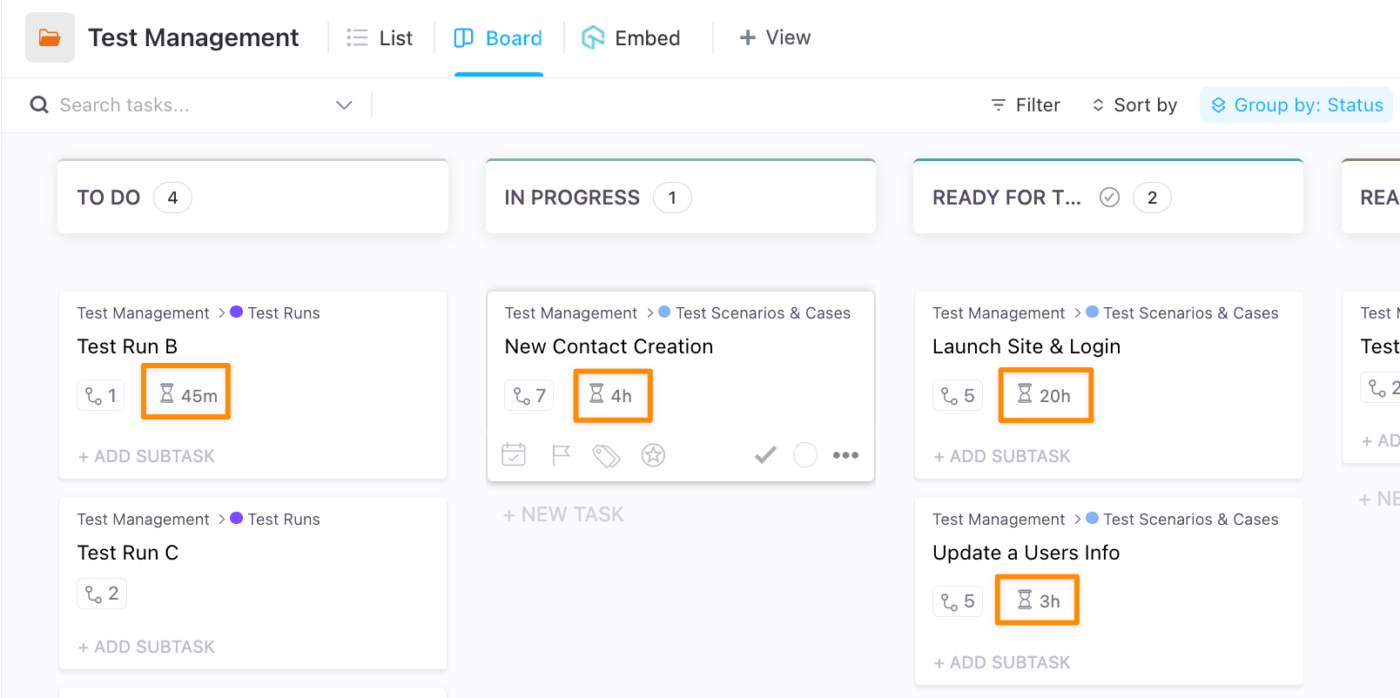
💡 Pro Tip: Track actual time lost to delays using ClickUp’s built-in time tracking, and roll up totals for reporting and claims. Compare estimated vs. actual delay durations at the task, list, or project level for more accurate forecasting.
Once your fragnet is defined, place it into the accepted schedule statused prior to the delay—not an outdated baseline. This keeps your analysis current and credible.
ClickUp Gantt View makes it easy to drop your fragnet into the live schedule and see how it connects to upstream and downstream tasks.
Here’s how it looks when you simulate the delay:
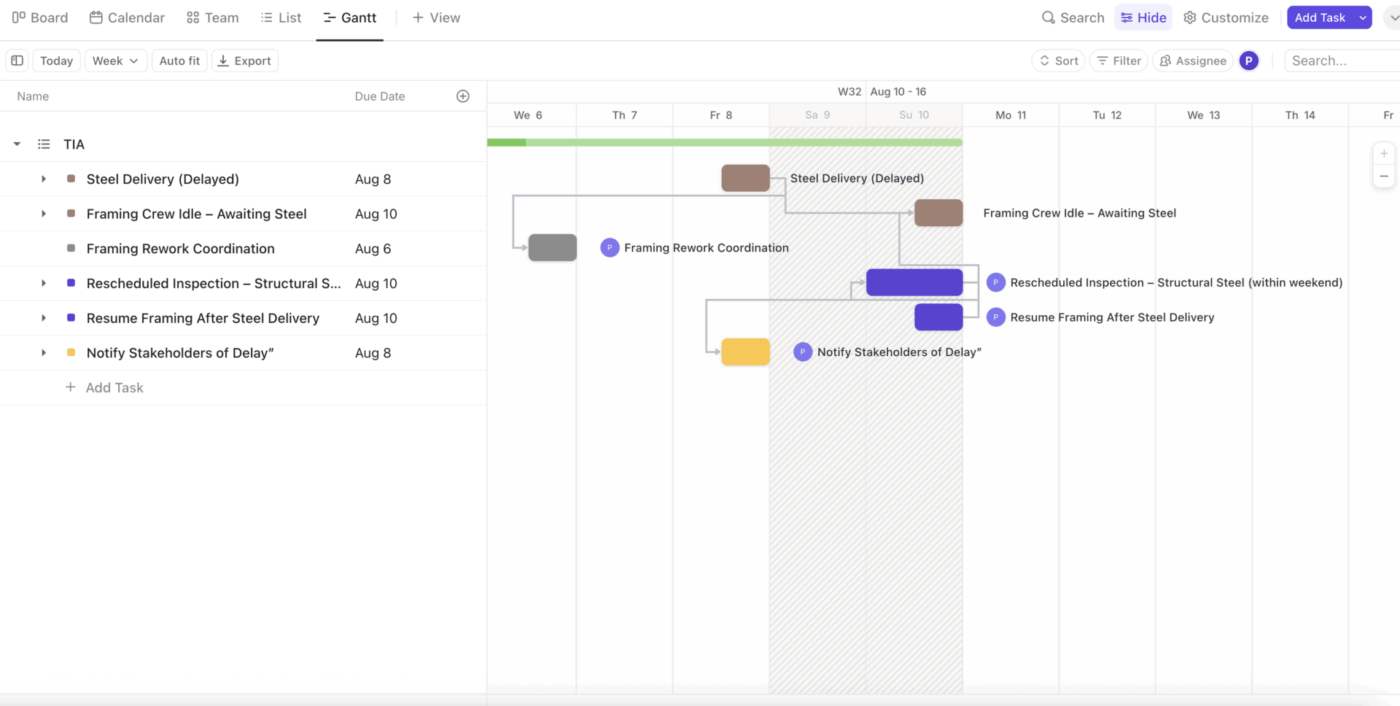
📅 Model delays with live dependencies in Gantt View—instantly visualize how your fragnet affects the timeline and critical path.
In this example, the delayed steel delivery delays the framing crew, rescheduled inspections, and stakeholder communication. All changes update dynamically in your critical path—no spreadsheet formulas or guesswork required.
🎉 Fun Fact: The shortest recorded commercial construction project? A pop-up hotel in China was assembled in under 6 days using modular units and a ruthless schedule. Fragnet analysis, anyone?
Now, run the schedule recalculation. This is the moment of truth: you’ll see whether the delay pushes out the critical path or if there’s enough float to absorb it.
ClickUp Gantt View automatically updates timelines and highlights changes to dependencies and milestones. While ClickUp does not perform advanced CPM logic or automated critical path recalculation, you can visually assess the impact and use Dashboards to track changes in milestone dates, new dependencies, and slippage in task start/finish times.
Keep your eye on:
💡 Pro Tip: Integrate ClickUp with your Google Calendar or Slack so delay impacts appear in everyone’s daily agenda or team channels, keeping communication seamless.
Finally, compare the updated schedule with your original version to understand the net time impact. This gives you a clear answer: how many days are added, which deliverables move, and where the risk lies.
With ClickUp Dashboards, build custom widgets to visualize delay trends, cumulative impacts, and project health—using timelines, pie charts (delay causes), and workload views. You can set up side-by-side timeline widgets to compare baseline and current schedules, and share insights with your team or clients.

📊 This comparison is what you’ll use for internal decisions, client updates, or formal delay claims.
🔍 Quick Checklist: How to Perform a Time Impact Analysis
✅ Identify and document the delay event
✅ Create a realistic fragnet with dependencies
✅ Insert the fragnet into the last accepted schedule
✅ Recalculate to assess changes in the critical path
✅ Compare results and document the time impact
✅ Communicate findings with clear visuals
Think of the ClickUp Time Impact Analysis Template as your virtual control room for managing delays: It helps you track, analyze, and visualize how time is being used across projects, especially when you’re simulating delays.
With integrated Custom Fields, time tracking, and multiple views, you can capture everything from idle time hours to cost per hour, and roll up data for precise analysis.
Key features include:
Let’s say you’re managing a large commercial construction project—think high-rise office tower—and your team is halfway through the structural framing phase. Suddenly, the steel delivery that was supposed to arrive on Day 90 gets pushed to Day 105 due to supplier delays.
Now you need to answer two urgent questions:
Here’s how a Time Impact Analysis would unfold:
Delay Type: Late delivery of structural steel
Original Delivery Date: Day 90
Revised Delivery Date: Day 105
Downstream Impact: Framing, inspections, and subsequent trades are blocked
You model a fragnet that includes:
Each task is connected with dependencies and assigned estimated durations.
You add the fragnet to your most recent project schedule at Day 90—the original delivery date—and recalculate the schedule.
After running the schedule update:
💡 Pro Tip: Communicate early and often. A well-timed TIA won’t just help your team—it builds trust with clients who want transparency, not surprises.
Time Impact Analysis can be a powerful tool—but only when done right. If you skip a step, use outdated data, or fudge the assumptions, you risk making your schedule look more reliable than it is (which never ends well 😬).
Here are the most common missteps to watch out for—and how to avoid them:
Running a TIA based on a stale schedule is like asking a GPS for directions using last year’s road map. Your analysis will be off, your critical path won’t reflect current progress, and your delay impact will be unreliable.
✅ Use the most recently updated, approved schedule. If your baseline isn’t accurate, the time impact won’t be either.
A vague or oversimplified fragnet will not capture the true complexity of a delay. It might miss dependencies, float time, or resource bottlenecks, leading to misleading results.
✅ Make your fragnet realistic. Model tasks as they would play out on-site, with accurate durations and links.
Some teams build a fragnet but forget to run the recalculation—or they rely on visual estimates instead of proper CPM logic. This defeats the whole purpose of TIA.
✅ Always recalculate the schedule after inserting a fragnet. The critical path logic is the foundation of your analysis.
Analyzing each delay in isolation is tempting, but delays often pile up. If you don’t track cumulative impacts, you underestimate the real schedule risk.
✅ Maintain a running TIA log or scenario plan that layers multiple delays over time.
Even if your analysis is perfect, it won’t help unless stakeholders understand it. Overly technical reports or buried timelines frustrate everyone.
✅ Use visuals, dashboards, or annotated Gantt charts to show the impact clearly. Bonus: ClickUp Dashboards make this way easier. 😉
💡 Pro Tip: It’s smart to run rolling TIAs for large infrastructure or multi-phase builds—repeating the process at key intervals. This helps track evolving delay risk and keeps documentation audit-ready at every project stage.
Time Impact Analysis isn’t just about knowing the steps—it’s about having the right tools to execute them clearly and consistently. You need a platform that can handle complex scheduling logic, simulate changes without breaking things, and communicate outcomes visually to stakeholders.
Here are some of the best tools teams use to perform TIA effectively:
ClickUp brings together everything you need to run a clean Time Impact Analysis—without hopping between six different tools.
With ClickUp Gantt Charts, you can visualize your project timeline, manually add a fragnet (as a group of tasks), and see how it affects dependencies and milestones. Use ClickUp Docs to create living delay logs, TIA reports, or lessons-learned repositories linked directly to relevant tasks and schedules. Share your findings through Dashboards that update in real time and automate notifications when delayed events are logged, keeping everyone in the loop.
⏩ AI Capability: ClickUp Brain gives you real-time summaries of project progress, lets you query delay scenarios in plain English, and auto-generates updates for stakeholders based on actual work data.
Primavera P6 is a heavyweight in construction and infrastructure scheduling. It’s robust, logic-based, and ideal for creating and analyzing multiple fragnet scenarios. But it comes with a steep learning curve, and collaboration across teams can feel clunky.
Use case: Great for large-scale engineering projects with formal TIA requirements.
MS Planner, formerly known as MS Project, is a solid choice for basic TIA workflows—especially for teams already using the Microsoft ecosystem. You can build fragnets, link dependencies, and track slippage. However, it lacks built-in collaboration tools or AI support, so sharing and documenting results requires extra effort.
Use case: Good for small to mid-sized projects where PMs already rely on Office tools.
ASTA PowerProject is designed for construction scheduling, with handy templates and a user-friendly UI for inserting delay events. Its 3D BIM integration is a plus for visualizing schedule changes. However, it’s more popular in Europe and may have limited adoption depending on your region.
Use case: Construction-focused teams who want a balance of power and ease.
📋 Industry Standards to know
Want your TIA to hold up in formal reviews or disputes? These two documents are your best friends:
Following their guidance ensures your delay analysis is both credible and contract-compliant.
Time Impact Analysis is a powerful tool, but it’s not always right. Other delay analysis methods might be more appropriate depending on the type of delay, the project phase, and the level of documentation available.
Here’s how to decide whether TIA is the best fit—or should you reach for another approach.
Real-world scenario: A design change gets submitted mid-project. You want to know if it’s worth accelerating other tasks or requesting a time extension.
🧐 Did You Know? Concurrent delays, or when two or more delays happen simultaneously, are notoriously difficult to evaluate. Most courts or adjudicators require a separate analysis for each delay path. TIA alone won’t suffice unless paired with a retrospective method, such as as-planned vs. as-built, to determine entitlement.
💡 Pro Tip: TIA is primarily a prospective analysis technique, but it can be applied retrospectively if you have accurate as-built data and a reliable baseline to compare against. However, remember that retrospective use introduces a risk of hindsight bias—so it’s best used with forensic analysis tools.
Alternative methods may include:
And with tools like ClickUp Dashboards and Project Time Tracking, you can monitor live data and model schedule impacts without spreadsheets or siloed systems.
💡 Pro Tip: TIA is best used during project execution to avoid delays—not just after problems accumulate. If you’re managing active risk and need a fast way to visualize impact, it’s your go-to method.
Delays don’t have to derail your project—as long as you know how to manage them. Time Impact Analysis allows you to simulate disruptions, calculate the impact on your timeline, and respond with data—not guesswork.
Let’s recap what you now know:
Whether you’re leading a construction project, managing government contracts, or just trying to stay ahead of scope creep, TIA helps you turn “this might cause a delay” into a clear, confident plan.
Start running smarter, faster Time Impact Analyses with ClickUp—sign up free today. 🎯
© 2025 ClickUp